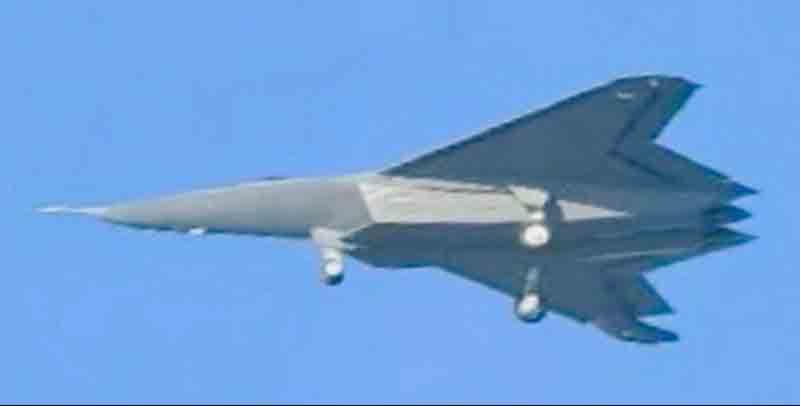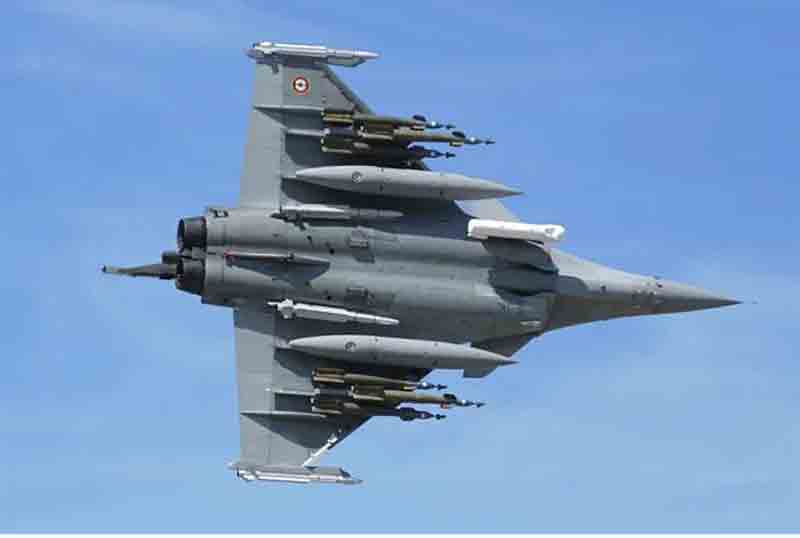China’s ambitious sixth-generation J-50 fighter, meticulously developed by Shenyang Aircraft Corporation (SAC), was observed today undertaking extensive test flights within Chinese airspace. Striking images circulating on social media have offered unprecedented insights into the advanced twin-engine configuration of the J-50, reinforcing evaluations that this aircraft is designed as an Air Dominance platform, directly competing with America’s forthcoming F-47 sixth-generation fighter.
The competition to create sixth-generation fighter jets has heightened the strategic rivalry between the United States and China, as both countries strive for air superiority in the decades ahead. The U.S. is pursuing its Next Generation Air Dominance (NGAD) initiative, which aims to deploy a highly stealthy, AI-driven fighter capable of commanding unmanned wingmen and asserting control over contested airspace.
Simultaneously, China is progressing with its own sixth-generation aircraft, particularly the J-36 and J-50, reflecting Beijing’s determination to challenge U.S. aerial supremacy, especially in the Indo-Pacific region. This technological rivalry is influencing the future of aerial combat, with significant implications for global power dynamics and deterrence strategies.
Experts examining the J-50’s design highlight its incorporation of cutting-edge technologies focused on achieving air superiority, facilitating network-centric operations, and ensuring survivability in highly contested environments.
The J-50 is reported to feature sophisticated artificial intelligence (AI) within its flight management system, which can autonomously assess intricate combat situations, recognize threats, and make tactical decisions. This capability significantly alleviates the pilot’s workload while improving strategic operational effectiveness.
The aircraft made its inaugural flight over Shenyang, Liaoning Province, on December 26, 2024, representing a significant advancement in China’s aspirations for airpower.
Experts have pointed out two notable systems integrated into the J-50: the Electro-Optical Targeting System (EOTS) and Thrust Vector Control (TVC).
The EOTS is a cutting-edge sensor array that utilizes electro-optical and infrared technology to detect, track, and accurately engage both aerial and ground targets over extensive distances, regardless of weather or visibility conditions, day or night. It includes high-resolution imaging sensors, Forward-Looking Infrared (FLIR) cameras, and precision laser designators that effectively direct a range of precision-guided munitions, including advanced air-to-ground missiles and smart bombs.
Moreover, the addition of Thrust Vector Control (TVC) grants the J-50 exceptional agility, allowing its engine nozzles to adjust dynamically during flight, which greatly enhances its combat maneuverability, especially in close-range dogfights.
China’s concurrent testing of two sixth-generation fighter programs—the J-50 developed by the Shenyang Aircraft Corporation (SAC) and the J-36 from the Chengdu Aircraft Corporation (CAC)—demonstrates Beijing’s strategic aim to achieve air superiority in the Indo-Pacific as geopolitical rivalries escalate.
Chinese defense experts predict that both the J-36 and J-50 will be operational within the People’s Liberation Army Air Force (PLAAF) by the early to mid-2030s, coinciding with China’s objective to establish dominance in contested airspaces, especially against Western and regional competitors.
In addition to these sixth-generation initiatives, China is also advancing the J-35 fighter jet, its second fifth-generation aircraft from SAC, which complements the CAC’s J-20 Mighty Dragon.
The J-35, designed for carrier operations, plays a vital role in China’s growing naval aspirations, while a land-based version is also under development, enhancing its strategic versatility. In a significant regional security move, Pakistan has officially decided to procure 40 units of the advanced J-35A fighters, highlighting Islamabad’s strategic shift to bolster its air capabilities amid rising geopolitical tensions, particularly with India.
Design Features of the J-50:
• Wing Design: Utilizes a stealth-enhanced, tailless lambda wing structure characterized by sharply angled sweeps and downward-angled wingtips, which improve aerodynamic efficiency and minimize radar visibility.
• Control Mechanism: Incorporates advanced rotatable wingtips that replace conventional vertical stabilizers, enhancing aerodynamic maneuverability and significantly bolstering stealth capabilities.
• Engine Configuration: Equipped with dual engines housed in streamlined nacelles that feature Diverterless Supersonic Intakes (DSI), which greatly reduce radar signatures while enhancing performance at supersonic speeds.
Operational Roles and Strategic Significance:
Preliminary evaluations indicate that the J-50 is carefully designed for exceptional performance in contested air environments, incorporating stealth features, advanced radar-absorbing materials, and cutting-edge sensors to enable coordinated operations with unmanned combat aerial vehicles (UCAVs), thereby transforming air combat strategies in the Indo-Pacific region.
Development Status:
As of April 2025, the J-50 is still undergoing initial flight tests, with only one confirmed prototype in operation. However, detailed information regarding its avionics, weapon systems, and combat performance metrics remains classified and is expected to evolve throughout the development process.
Additional Information:
Current knowledge about the J-50 is primarily based on initial observations and expert evaluations, with more definitive information expected as the aircraft progresses toward operational readiness.
Discover more from Defence Talks | Defense News Hub, Military Updates, Security Insights
Subscribe to get the latest posts sent to your email.





